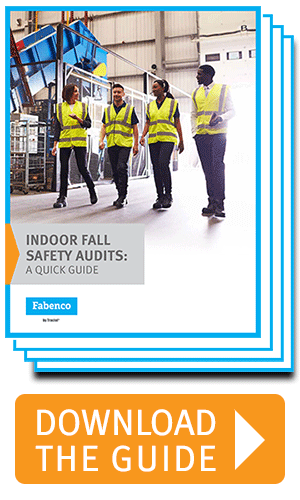
For the sixth year in a row, fall protection violations topped the list of the most frequently cited OSHA violations. With these stats in mind, it’s easy to see why developing policies and procedures to identify and address fall risks is vital to providing a safe working environment. Failure to provide the proper indoor fall protection can put manufacturing companies at an increased risk – not only for OSHA violations but for preventable employee injuries.
Fortunately, you can help minimize fall risks by regularly inspecting the areas of your manufacturing facility that are hot spots for OSHA inspectors. Start mapping out your plan today with this 6-point indoor fall protection checklist:
1) Mezzanines
An unprotected mezzanine is an open invitation for an OSHA violation. Manufacturing companies are required to have a mezzanine safety gate and guardrails around all edges to help prevent falls. Additionally, manufacturers must provide fall protection to employees who are loading and unloading goods from elevated platforms. Here are some questions to consider as you evaluate the mezzanines in your facility.
- Are all your mezzanines structurally sound?
- Are there handrails or a mezzanine safety gate around every edge of your mezzanine?
- Are there signs notifying employees of the mezzanine’s load capacity?
- Are employees completely protected when they load and unload materials from a mezzanine?
2) Loading docks
“Employers would not be required to install guardrail systems on the working side of platforms, such as loading docks, where the employer can demonstrate that the presence of guardrails would prevent the performance of work. All other sides of the loading docks must be guarded.” – John B. Miles, Jr., Director, Directorate of Enforcement Programs, OSHA
Unprotected loading docks pose a threat to the well-being of employees and delivery personnel. The most common injuries sustained in loading dock areas include falls from the dock and injuries that result when trucks separate from the dock. With 25% of all warehouse injuries occurring on loading docks, your facility inspection should include a thorough evaluation of your platform area to ensure loading dock safety. In particular, it should make sure that the loading dock area is properly protected with safety guardrails and a safety gate.
![Dowload the Indoor Fall Safety Audit Guide]() 3) Stairs
3) Stairs
Stairs should be regularly inspected to verify that they are structurally sound and inspections should include the following:
- Stairs and stairways must be free of obstacles that could cause users to trip or fall.
- Fixed stairs with four or more risers should be accompanied by well-secured railings.
- Stairs should be inspected for missing or damaged stair treads.
- A safety gate should be utilized at a stairway opening to protect workers from accidental falls.
4) Doorways and walkways
Your 6-point inspection process should begin by carefully screening each doorway and walkway within your facility. Doorways and walkways should be kept clear of equipment and other obstructions that could cause employees to trip or fall. Ladders, in particular, should be kept away from doors and walkways, as recommended by OSHA:
“Don’t set up ladders in areas such as doorways or walkways where others may run into them, unless they are protected by barriers. Keep the area around the top and base of the ladder clear. Don’t run hoses, extension cords, or ropes on a ladder and create an obstruction.” – OSHA Fall Prevention Training Guide
5) Handrails and Stair Railings
The reliability of stair railings is just as vital to reducing fall risks as the structural integrity of the stairs themselves. OSHA outlines specific requirements for handrails and stair railings, mandating that they be properly positioned and able to support at least 200 pounds of weight applied within 2 inches of the top edge of the railing. Handrails must also offer a sufficient handhold for employees to grasp to help reduce falls. When inspecting your facility, make sure that stair railings are sturdy, well-constructed, and fully secured to the wall.
6) Safety Signs
“All signs shall be furnished with rounded or blunt corners and shall be free from sharp edges, burrs, splinters, or other sharp projections. The ends or heads of bolts or other fastening devices shall be located in such a way that they do not constitute a hazard.” – Occupational Safety and Health Administration
Safety signage plays an instrumental role in loading dock safety, mezzanine fall protection, and overall fall prevention. Signs should be clearly worded and should be easy for employees to understand. Safety signs should be clean, securely mounted, and free from obstruction by equipment or architecture.
What is the most effective way to help prevent falls?
The most effective way for manufacturing companies to reduce the risk of falls is to invest in a quality, OSHA-compliant safety gate. Reputable brands of safety gates are usually to easy to install as well, enabling you to offer enhanced protection to your employees in a timely manner. In some cases, they can be used in conjunction with guardrail systems to ensure that all sides of a mezzanine, floor hole, or loading dock are protected.
No matter how you approach indoor fall protection, you’ll need to begin somewhere – and continue to audit your safety measures at regular intervals. Careful monitoring, the removal of obstacles, and the addition of a simple protection system like a mezzanine safety gate or a loading dock safety gate go a long way when it comes to keeping your employees safe. With these tips in hand, your manufacturing company’s fall protection is off to a solid start. Need more detailed guidance? We’d be happy to help.














